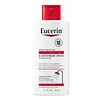What's inside
What's inside
 Key Ingredients
Key Ingredients

 Benefits
Benefits

 Concerns
Concerns

 Ingredients Side-by-side
Ingredients Side-by-side

Colloidal Oatmeal 2%
AbsorbentWater
Skin ConditioningIsopropyl Palmitate
EmollientGlycerin
HumectantCetearyl Alcohol
EmollientSodium Cocoamphoacetate
CleansingCaprylic/Capric Triglyceride
MaskingOctyldodecanol
EmollientC12-15 Alkyl Benzoate
AntimicrobialSodium Myreth Sulfate
CleansingCetearyl Isononanoate
EmollientXanthan Gum
EmulsifyingCeramide NP
Skin ConditioningAlanine
MaskingArginine Hcl
Skin ConditioningCarnitine
CleansingGlycine
BufferingSodium PCA
HumectantLauryl Glucoside
CleansingCitric Acid
BufferingSodium Chloride
MaskingPhenoxyethanol
PreservativeCarbomer
Emulsion StabilisingSodium Hydroxide
BufferingPentylene Glycol
Skin ConditioningDecylene Glycol
Skin ConditioningSodium Benzoate
MaskingColloidal Oatmeal 2%, Water, Isopropyl Palmitate, Glycerin, Cetearyl Alcohol, Sodium Cocoamphoacetate, Caprylic/Capric Triglyceride, Octyldodecanol, C12-15 Alkyl Benzoate, Sodium Myreth Sulfate, Cetearyl Isononanoate, Xanthan Gum, Ceramide NP, Alanine, Arginine Hcl, Carnitine, Glycine, Sodium PCA, Lauryl Glucoside, Citric Acid, Sodium Chloride, Phenoxyethanol, Carbomer, Sodium Hydroxide, Pentylene Glycol, Decylene Glycol, Sodium Benzoate
 Reviews
Reviews

Ingredients Explained
These ingredients are found in both products.
Ingredients higher up in an ingredient list are typically present in a larger amount.
Citric Acid is an alpha hydroxy acid (AHA) naturally found in citrus fruits like oranges, lemons, and limes.
Like other AHAs, citric acid can exfoliate skin by breaking down the bonds that hold dead skin cells together. This helps reveal smoother and brighter skin underneath.
However, this exfoliating effect only happens at high concentrations (20%) which can be hard to find in cosmetic products.
Due to this, citric acid is usually included in small amounts as a pH adjuster. This helps keep products slightly more acidic and compatible with skin's natural pH.
In skincare formulas, citric acid can:
While it can provide some skin benefits, research shows lactic acid and glycolic acid are generally more effective and less irritating exfoliants.
Most citric acid used in skincare today is made by fermenting sugars (usually from molasses). This synthetic version is identical to the natural citrus form but easier to stabilize and use in formulations.
Read more about some other popular AHA's here:
Learn more about Citric AcidSodium Benzoate is a preservative. It's used in both cosmetic and food products to inhibit the growth of mold and bacteria. It is typically produced synthetically.
Both the US FDA and EU Health Committee have approved the use of sodium benzoate. In the US, levels of 0.1% (of the total product) are allowed.
Sodium benzoate works as a preservative by inhibiting the growth of bacteria inside of cells. It prevents the cell from fermenting a type of sugar using an enzyme called phosphofructokinase.
It is the salt of benzoic acid. Foods containing sodium benzoate include soda, salad dressings, condiments, fruit juices, wines, and snack foods.
Studies for using ascorbic acid and sodium benzoate in cosmetics are lacking, especially in skincare routines with multiple steps.
We always recommend speaking with a professional, such as a dermatologist, if you have any concerns.
Learn more about Sodium BenzoateXanthan gum is used as a stabilizer and thickener within cosmetic products. It helps give products a sticky, thick feeling - preventing them from being too runny.
On the technical side of things, xanthan gum is a polysaccharide - a combination consisting of multiple sugar molecules bonded together.
Xanthan gum is a pretty common and great ingredient. It is a natural, non-toxic, non-irritating ingredient that is also commonly used in food products.
Learn more about Xanthan Gum